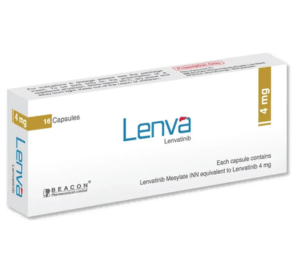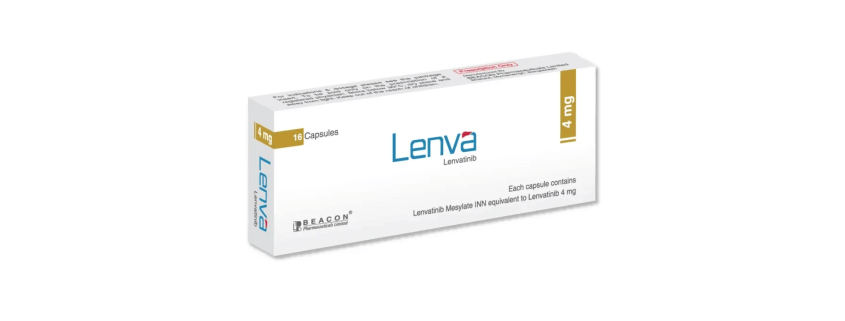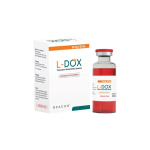Lenva

Generic Name:Lenvatinib Mesylate
Indications
Lenva is a kinase inhibitor that is indicated:
- Differentiated Thyroid Cancer: Lenva is indicated for the treatment of patients with locally recurrent or metastatic, progressive, radioactive iodine-refractory differentiated thyroid cancer (DTC).
- Renal Cell Carcinoma: Lenva is indicated in combination with Everolimus for the treatment of patients with advanced renal cell carcinoma (RCC) following one prior anti-angiogenic therapy.
- Hepatocellular Carcinoma: Lenva is indicated for the first-line treatment of patients with unresectable hepatocellular carcinoma (HCC).
- Endometrial Carcinoma: Lenva, in combination with Pembrolizumab, is indicated for the treatment of patients with advanced endometrial carcinoma that is not microsatellite instability-high (MSI-H) or mismatch repair deficient (dMMR), who have disease progression following prior systemic therapy and are not candidates for curative surgery or radiation.
Pharmacology
Lenvatinib is a kinase inhibitor that inhibits the kinase activities of vascular endothelial growth factor (VEGF) receptors VEGFR1 (FLT1), VEGFR2 (KDR), and VEGFR3 (FLT4). Lenvatinib inhibits other kinases that have been implicated in pathogenic angiogenesis, tumor growth, and cancer progression in addition to their normal cellular functions, including fibroblast growth factor (FGF) receptors FGFR1, 2, 3, and 4; platelet-derived growth factor receptor alpha (PDGFR ), KIT, and RET. Lenvatinib also exhibited antiproliferative activity in hepatocellular carcinoma cell lines dependent on activated FGFR signaling with concurrent inhibition of FGF-receptor substrate 2 (FRS2 ) phosphorylation.
Absorption: The time to peak plasma concentration (Tmax) typically occurred from 1 to 4 hours post-dose. Administration with a high-fat meal (approximately 900 calories of which approximately 55% were from fat, 15% from protein, and 30% from carbohydrates) did not affect the extent of absorption, but decreased the rate of absorption and delayed the median Tmax from 2 hours to 4 hours.
Distribution: In vitro binding of Lenvatinib to human plasma proteins ranged from 98% to 99% at concentrations of 0.3 to 30 μg/mL. The blood-to-plasma concentration ratio ranged from 0.59 to 0.61 at concentrations of 0.1 to 10 μg/mL in vitro.
Metabolism: The main metabolic pathways for Lenvatinib in humans were identified as enzymatic (CYP3A and aldehyde oxidase) and non-enzymatic processes. Excretion: Ten days after a single administration of radiolabeled Lenvatinib, approximately 64% and 25% of the radiolabel were eliminated in the feces and urine, respectively.
Elimination: The terminal elimination half-life of Lenvatinib was approximately 28 hours.
Dosage
Important Dosage Information: The dose reduction is needed for certain patients with renal or hepatic impairment. Lenvatinib should be taken once daily, with or without food, at the same time each day. If a dose is missed and cannot be taken within 12 hours, skip that dose and take the next dose at the usual time of administration.
Recommended Dosage for Differentiated Thyroid Cancer (DTC): The recommended dosage of Lenvatinib is 24 mg orally once daily until disease progression or until unacceptable toxicity.
Recommended Dosage for Renal Cell Carcinoma (RCC): The recommended dosage of Lenvatinib is 18 mg in combination with 5 mg Everolimus orally once daily until disease progression or until unacceptable toxicity.
Recommended Dosage for Hepatocellular Carcinoma (HCC): The recommended dosage of Lenvatinib is based on actual body weight: 12 mg for patients greater than or equal to 60 kg or 8 mg for patients less than 60 kg. Lenvatinib should be taken orally once daily until disease progression or until unacceptable toxicity.
Recommended Dosage for Endometrial Carcinoma: The recommended dosage of Lenvatinib is 20 mg orally once daily, in combination with Pembrolizumab 200 mg administered as an intravenous infusion over 30 minutes every 3 weeks, until unacceptable toxicity or disease progression.



